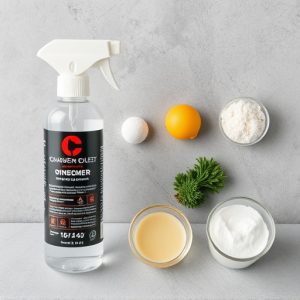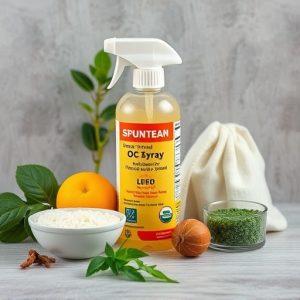Decoding Oleoresin Capsicum (OC): Essentials, Usage, and Safety Regulations
OC spray, or oleoresin capsicum, is a non-lethal self-defense tool derived from hot chili peppers a…….
OC spray, or oleoresin capsicum, is a non-lethal self-defense tool derived from hot chili peppers and serves as an effective deterrent against human and animal attackers. The key to its potency lies in the specific concentration of active capsaicinoid compounds found within the spray, which cause intense irritation upon contact with eyes, skin, or mucous membranes, temporarily incapacitating the assailant. OC sprays are formulated with a precise blend of oleoresin capsicum, a diluent such as isopropyl alcohol, and a propellant, often CO2 or other gas propellants, with additional additives that enhance stability and performance. The concentration of OC in these sprays varies, influencing the spray's intensity. Users must be well-informed about the oc spray ingredients to use them effectively, considering personal sensitivities or health conditions like asthma, and must adhere to local laws when selecting a pepper spray for personal defense. Safety testing of OC spray ingredients is stringent to ensure both user and target safety, making OC sprays a reliable tool for self-defense that complies with federal and regional standards.
explore the potent properties of oleoresin capsicum (OC), a key ingredient in self-defense sprays. This article delves into the composition and effects of OC, its pivotal role in personal safety, and the regulatory frameworks surrounding its use. Understanding OC spray ingredients is crucial for anyone considering pepper spray as a defense mechanism. Join us as we unravel the science behind this natural deterrent and ensure your knowledge aligns with current safety and manufacturing standards.
Understanding Oleoresin Capsicum (OC): A Pungent Defense Mechanism
Oleoresin capsicum, commonly known as OC, is a potent self-defense tool derived from the fruit of Capsicum species. This pungent compound is not merely a deterrent to potential assailants but also serves as a natural defense mechanism for the plant itself, deterring herbivores with its fiery taste and intense irritation. The effectiveness of OC sprays, which are among the most widely used non-lethal self-defense products, hinges on the concentration and composition of their active ingredients. These sprays contain oleoresin capsicum, along with other components such as oils and resins from the chili peppers that enhance its stickiness and adherence to skin and mucous membranes, amplifying the incapacitating effect.
When integrated into pepper spray formulations, oleoresin capsicum acts as a highly effective irritant. It triggers an immediate reaction upon contact with the eyes, skin, or respiratory tract of an attacker. This reaction causes intense pain and discomfort, effectively immobilizing the individual long enough for escape or for law enforcement to intervene. The ingredients in OC sprays are carefully selected and standardized to ensure consistency in their defensive capabilities. Understanding the role of oleoresin capsicum in these sprays is crucial for users to recognize its value as a safety tool, not just for personal protection but also as a non-lethal alternative in law enforcement and crowd control scenarios.
OC Spray Ingredients: Breaking Down the Components of Pepper Spray
Oleoresin capsicum, commonly abbreviated as OC, is the active ingredient in pepper spray, a non-lethal self-defense tool widely used by civilians and law enforcement. The term “oleoresin capsicum” refers to an oily extract of ground hot peppers (such as cayenne) that contains capsaicinoids, which are the compounds responsible for the intense heat of chili peppers. When formulated into pepper spray, these capsaicinoids create a potent irritant that can incapacitate an attacker by causing a strong reaction upon contact with mucous membranes and skin.
The components of OC spray are carefully selected to maximize its defensive capabilities while ensuring it is safe for legitimate users when used according to instructions. Typically, the sprays contain oleoresin of capsicum, a diluent (such as isopropyl alcohol), an inert propellant (like compressed CO2 or other gas propellants), and sometimes other additives that can enhance stability, performance, and shelf life. The concentration of oleoresin capsicum can vary between different products, influencing the intensity of the spray’s effects. It is crucial for users to understand the specific oc spray ingredients in their self-defense spray to know how to use it effectively and to be aware of any potential sensitivities or contraindications, especially if they have pre-existing conditions such as asthma or sensitive eyes. Understanding the composition also allows users to make informed decisions when selecting a pepper spray that suits their needs and legal regulations in their area.
The Role of Oleoresin Capsicum in Self-Defense and Personal Safety
Oleoresin capsicin, commonly referred to as oleoresin capsicum (OC), is a key ingredient in many self-defense sprays designed for personal safety. This substance is derived from chili peppers and possesses a high concentration of capsaicinoids, which are the compounds responsible for the pungent heat associated with chili peppers. When formulated into an OC spray, these capsaicinoids create an irritant that can incapacitate an attacker. Upon contact with the eyes, face, or skin, OC spray triggers a strong sensation of burning pain, effectively deterring assailants by causing significant discomfort and impaired vision, thereby allowing the victim to escape.
The efficacy of OC sprays in self-defense is underscored by their non-lethal nature and legal status across many jurisdictions. Unlike firearms or other weapons that can lead to irreversible harm or fatality, OC spray is designed to deliver a temporary yet powerful defense mechanism. The ingredients in OC sprays are rigorously tested to ensure they adhere to safety standards for the user as well as the target. This targeted delivery of capsaicinoids means that it can be an effective tool for personal safety with minimal risk of long-term effects on individuals. Users are advised, however, to familiarize themselves with the proper use and legal restrictions governing the use of OC sprays in their specific region. Understanding how to aim, deploy, and avoid accidental exposure is crucial for the effectiveness and safety of using oleoresin capsicum as a self-defense measure.
Safety and Regulations Governing Oleoresin Capsicum Use and Manufacturing
Oleoresin capsicum, commonly known as oleoresin of Capsicum Annuum, is an oily extract from chili peppers that imparts the pungent heat associated with the peppers. When formulated into pepper spray, it serves as a non-lethal self-defense tool widely used by law enforcement and civilians alike. The safety of oleoresin capsicum products is paramount, which is why they are subject to stringent regulations during both their use and manufacturing processes. The ingredients in OC sprays, including oleoresin capsicum, must be carefully measured to ensure that the spray delivers an effective yet non-harmful dose. For instance, the Scoville Heat Unit (SHU) level is carefully controlled to avoid overexposure that could cause severe irritation or harm.
Manufacturers of oleoresin capsicum-based products must adhere to the guidelines set forth by the U.S. Food and Drug Administration (FDA), as well as other regional regulatory bodies. These regulations dictate the permissible levels of oleoresin capsicum in the final product, ensuring that it is both safe for use as a deterrent and not misused as a hazardous substance. The manufacturing process itself must comply with Good Manufacturing Practices (GMP) to guarantee the purity and consistency of the oleoresin capsicum ingredients. These practices include rigorous quality control measures, from sourcing the raw chili peppers to the final packaging of the pepper spray products. Through these safety and regulatory measures, users can trust that oleoresin capsicum-based self-defense sprays are both effective and safe for personal protection when used appropriately.


